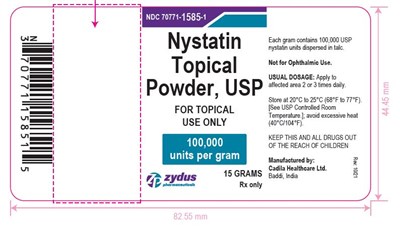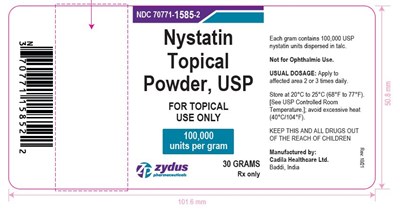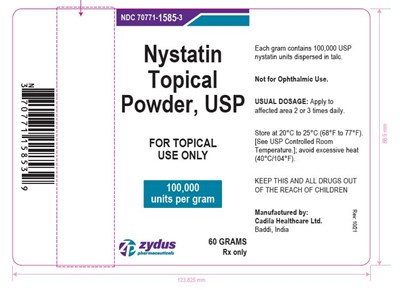Product Images Nystatin
View Photos of Packaging, Labels & Appearance
Product Label Images
The following 3 images provide visual information about the product associated with Nystatin NDC 70771-1585 by Zydus Lifesciences Limited, such as packaging, labeling, and the appearance of the drug itself. This resource could be helpful for medical professionals, pharmacists, and patients seeking to verify medication information and ensure they have the correct product.
15 gm label - a549e359 6277 490e 80e5 02e536e22362 01

Nystatin is a topical powder medication that is only for external use. It contains 100,000 units of USP nystatin per gram and is not recommended for use in the eyes. The usual dosage is to apply it to the affected area 2-3 times per day. It should be stored at a temperature between 20°C and 25°C (68°F to 77°F), and kept away from excessive heat. This medication is manufactured by Cadila Healtheare Ltd. in Badd, India. It is important to keep all drugs, including this one, out of the reach of children.*
30 gm label - a549e359 6277 490e 80e5 02e536e22362 02

Nystatin is a topical powder with 100,000 units per gram, dispersed in tal. It is for topical use only and should not be used for ophthalmic conditions. The usual dosage is applying it to the affected area 2 or 3 times daily. It should be stored at a controlled room temperature and kept away from children. It is manufactured by Cadila Healthcare Ltd. in Baddi, India.*
60 gm label - a549e359 6277 490e 80e5 02e536e22362 03

This text is a product description of Nystatin powder manufactured by Cadila Healthcare Ltd. Each gram contains 100,000 USP Nystatin units dispersed in talc. It is a topical medication, not for ophthalmic use, and should be stored at 20°C to 25°C. The drug should be kept out of the reach of children. The packaging contains 60 grams of the powder.*
* The product label images have been analyzed using a combination of traditional computing and machine learning techniques. It should be noted that the descriptions provided may not be entirely accurate as they are experimental in nature. Use the information in this page at your own discretion and risk.